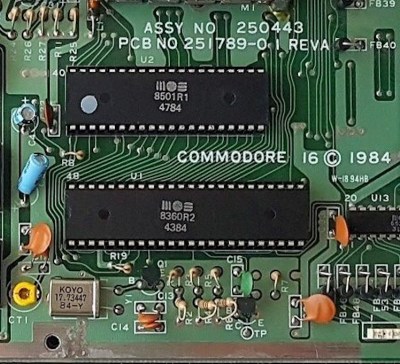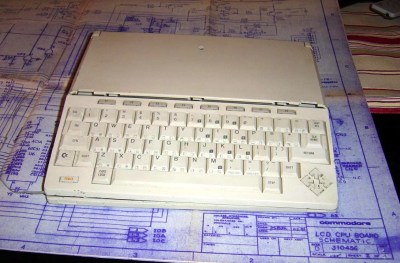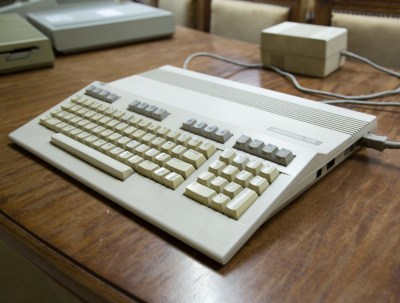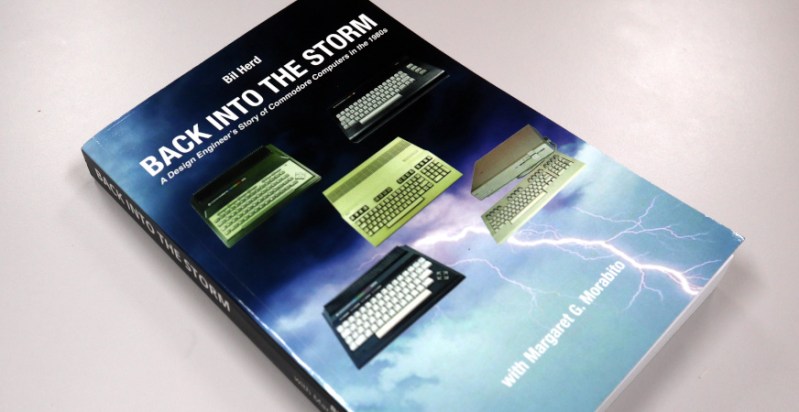It’s a morning ritual that we guess most of you share with us; before whatever work a new day will bring to sit down with a coffee and catch up with the tech news of the moment on Hackaday and other sites. Most of us don’t do many exciting things in our everyday lives, so reading about the coolest projects and the most fascinating new developments provides us with interest and motivation. Imagine just for a moment then that by a twist of fate you found yourself taking a job at the epicentre of the tech that is changing the world, producing the objects of desire and pushing the boundaries, the place you’d give anything to work at.
This is the premise behind our Hackaday colleague Bil Herd’s autobiographical chronicle of time in the mid 1980s during which he worked at Commodore, maker of some of the most iconic home computers of the day. We follow him through the three years from 1983 to 1986 as hardware lead on the “TED” series of computers including the Commodore 16 and Plus/4, and then the Commodore 128, a dual-processor powerhouse which was arguably the last of the big-selling 8-bit home computers.
It’s an intertwined set of narratives peppered with personal anecdotes; of the slightly crazy high-pressure world of consumer videogames and computing, the fine details of designing a range of 8-bit machines, and a fascinating insight into how the culture at Commodore changed in the period following the departure of its founder Jack Tramiel.
Jack Tramiel’s Vision For A Low-Cost Computer

Looking at the 8-bit computers of the early 1980s from our lofty perch here in 2021 it’s tempting to believe that all the machines with similar processors were equivalent to each other and in direct competition, but in Bil’s description of the landscape from which Jack Tramiel had conceived what would become the TED computers lies a reminder that the market was very much stratified. Processors such as the MOS 6502 and Zilog Z80 may have been at the heart of so many machines of the day, but their market positions depended so much more on the capabilities of their inbuilt video and sound hardware and other peripherals than it did on the microprocessor. Commodore had a runaway success story in the Commodore 64 as a premium gaming computer at the more expensive end of the market, but lacked an effective product to head off the threat from the much cheaper and less-well-specified Sinclair Spectrum at the lower end.
Tramiel’s vision was for a new architecture surrounding the 6502 that would integrate less capable video and sound into the TED, a much cheaper single chip perhaps analogous to the Sinclair’s Ferranti ULA, and simultaneously see off the competition for low-priced gaming hardware and open up an entirely new market for a budget business computer. The TED machines would be available in a three-model range starting at $49 and going up to a fully-fledged business desktop with a numerical keypad and a talking GUI.

Bil describes the early TED period at Commodore as his “happy time”, and reading his account of a twenty-something hardware engineer catapulted into the position of bringing a new Commodore computer to life, it’s not difficult to see why. The tone changes over the book as the culture of the company shifted following the departure of Jack Tramiel, and for those of us who witnessed the catastrophic final years of the company through the lens of Amiga fandom it’s a glimpse into the roots of the company’s ultimate decline. He provides a candid look at Jack Tramiel’s management style from the viewpoint of someone who was really there rather than through heresay, and from that we gain a sense of how Commodore became the success story that it did.
Reading the book I’m left with the sense that we’ll never hear the true details surrounding his departure from the company he founded and subsequent piloting of Atari, so students of the later years of the home computer era will have to accept disappointment on that front. The book provides a personal view of how during this period without the founder’s vision the company fell under the spell of its marketing department, and the TED computers never appeared in the forms or at the price points which they deserved.
The Last Of The Great 8-Bit Computers

The first half of the book takes us from 1983 through 1984 and the genesis of the TED computers, then through a short interlude with the ill-fated LCD machine. The second half follows the development of the Commodore 128 up to its debut at the Consumer Electronics Show (CES) in 1985. This machine was the last new 8-bit mass-produced home computer platform to be released by a major manufacturer, and the tale of its development is particularly interesting because, despite Bil and his colleagues pushing at the edge of what was possible with 6502-derived parts, he describes it in such a way as to make it readily comprehensible to readers here in 2021. In some cases he’s doing things that would be relatively easy with modern test equipment but were extra-hard in the 1980s, such as when he uses persistence of vision and an analogue ‘scope to spot a transitory echo on a PCB line. This feat resulted in the bodge wire that adorns every single Commodore 128 board. The electronic engineer’s craft demonstrated in these pages as he solves bugs in custom silicon should make this book required reading for any electronics student aside from the retrocomputing angle.

The Commodore 128 with its two different microprocessors and three different operating environments comes through as an engineer’s machine — designed despite the work of the marketeers rather than because of them. He describes quietly not implementing a request for a proprietary video connector that wouldn’t work with non-Commodore monitors because it would have compromised the final machine, and this is one of many running battles that were fought to deliver the best product that could be made. The thought of what might have been is a theme that pervades Commodore fandom, and here we see that the engineers were on “our” side, that of the customer rather than with those in the company who seemingly had little idea about the end users. One of the saddest parts of the story concerns the number of machines that the company developed and then never released; we mentioned the unreleased TED computers and the LCD machine above but he also makes reference to entire ranges of business machines that never saw the light of day. The Commodore story might still have ended in the 1990s had more of them been put on the market, but there’s a vast sense of waste that such poor decisions were made about such promising hardware.
Reading the book as someone with a background in the computer game business during the following decade I immediately recognize the combination of bad management, very bright teams, a frenetic atmosphere, and extremely high pressure surrounding the industry’s trade shows. It’s a world that can deliver a huge buzz at the expense of fast burnout for those who aren’t careful, and Bil’s comments about seeking the adrenaline fix continuing after he left Commodore in early 1986 ring true. I was riveted by this book and have read it again more than once during the writing of this article. I wasn’t the only one here at Hackaday who bought a copy as soon as it came out, and I can only suggest that you find yourself a copy too.
Back into the Storm: A Design Engineer’s Story of Commodore Computers in the 1980s, by Bil Herd with Margaret Morabito, can be found for sale through Amazon, at $19.96 on the Kindle and $24.99 for a physical edition.















TIL: “TED” stands for Text Editing Device.
Internally we call it Text EDitor :)
Brian Bagnall seems to cover the later years.
That’s one for the Christmas list! I too recall the computer shows of the time – hard work, but always great fun. Not only because of what we were showing, but for the excitement emanating from the crowds coming to see it.
The Ted machines just couldn’t compete with the C-64 once the price on the C-64 started to come way down. It was in interesting machine in many ways but the C-64 had the software base. What they did have were a good drive interface and a better basic. Too bad that C-64 drives where so slow and the Basic so limited. Had it had a fast drive with byte accessible files, and a basic with support for graphics and sound it would have been unbelievable. But as it was it was a smash hit. The C128 was just too late which is really sad. Had it come out in place of the TEDs it would have been a huge hit.
I got my C64 in November 1982. So I had one of the first.
I got my C64 about a year later, as I started with a ZX81. I ended up with a second C64 when my first power supply crapped out.
One of my coworkers had a C128, and was tempted myself, mostly for the CP/M capability. One of the biggest issues back in the 80’s was lack of ability to share documents (even ASCII) between various systems. We had a Zenith 286 at work, and that was always an issue.
I also wanted as +4 bit when they made it non-compatible with the C64 it was a showstopper for me.
I worked as a cobol programmer in the 80s, coding with pencil and paper, waiting for the data prep girls to convert it into cards then waiting for a slot on the ICL 1900 mainframe to run it, then waiting for the fanfold printout that inevitably told of a failed run because of a missing full stop, and the walk of shame to the system analyst to confess my crime.
What a contrast to be able to go home and code some 6502 into my c64 and be able to get instant results. Marvelous.
Commodores were always my weapon of choice right through to the Amiga. And if I reach my left hand out right now my fingers feel the arrow pad on the bottom right of my Plus 4. It doesn’t get fired up much these days. But I never could consign it to the attic where my other 8 bit computers are.
Thanks Bil for writing the book – now on my kindle. And thanks Jenny for the heads up.
From the Title, I was expecting Bil Herd announcing a Reunion Tour or something…
(Looking forward to it happening!)
B^)
I will be speaking at VCF East in October if that counts. :)
If I attend virtually, would you autograph my ebook copy?
B^)
These are the machines where I cut my teeth at the HW level. By day I used glass room machines, often with punch cards for input. Evenings and weekends I had my Vic 20 and C64.
Very much looking forward to reading it. Thanks Bil for writing it.
I’ll definitely get a copy of this book. Commodore and my love of computers built a foundation that took me from a highschool dropout to the head of I.T. at a hospital. Even cooler that Mr. Herd comments on here! Thanks Mr. Herd!
Still sad the Commodore LCD never made it, I would have loved one of those.
I had hopes on the Apple ][ version with the LCD screen…
(sigh!)
+1 for the article and the book. The latter is on my Amazon list now.
Fastest Amazon purchase I ever made. This book will go well with my Commodore collection. Vic20, C64, C128, C128D, C16, Plus4, Max, and a bunch of software and peripherals. 8-bit Commodore basically gave me the knowledge to have a career when I grew up.
“This book will go well with my Commodore collection. Vic20, C64, C128, C128D, C16, Plus4, Max, and a bunch of software and peripherals. 8-bit Commodore basically gave me the knowledge to have a career when I grew up.”
You suck!
(don’t take it personally, I’m just being jealous!)
B^)
My very first home computer was a C16… the second: Amiga 500 :) Of course I had to buy this book and read it :D
I started my journey into the world of computers with this Commodore. This was my first computer and I started to learn BASIC with it.
I got the Commodore 64 for my birthday in 1982, and with it a book of all the Commodore 64 games I could play.
I was hooked on that computer ever since and we had many hours of fun playing. So now this computer was an old dinosaur, so why should I still care?
The Commodore 64 was a very successful computer during its time, it had more than 17.000.000 units sold. So I decided to take this old thing out of the garage and give it some fresh air. And once again it showed me that you don’t need a lot of memory and a huge hard drive to solve problems with a computer.
At that time we could not think that the main part of the data of our disks will be video and audio and the data has now moved to big data.
Everything has changed a lot since then, but it’s wonderful because now any phone is several times more powerful than that computer.
I think progress will change crypto and big data even more.
>Commodore 128, a dual-processor powerhouse
hahahahhaa. Paying for two processors (three in 128D) and two graphical chips, only ever using one at a time, all for the low low price of Atari ST (128D). 128 was a scam build reusing leftover inventory from other failures (MOS 8563). This instead of something like 2GS.
>Commodore 16 and Plus/4
in other words all the failures. Almost all C64 designers/engineers were fired or left of their own accord in 1982. From what I read they were all promised bonuses for meeting 1982 deadline, and by bonuses Jack Tramiel meant privilege of working for him ;-) That was Jack Tramiels Commodore way, get rid of expenses as soon as possible, only retain cheap and obedient workforce.
I wish there were better publicly available images of the LCD one. You can’t really tell what’s on the screen in anything I can see on Google. I never knew Commodore was working on anything like that at some point.
My illustrious career started in high school on a CBM 3016. The school had three of them and a 3032 with a dual floppy drive. Available for students to use after school time. A single floppy could hold all the programs you’d ever write.
I had to wait until I was making real money as an EE intern to buy my first own computer: A C128. With an audio cassette recorder I had to hack a DB9 connector onto. I also hacked the Philips monochrome monitor to accept both 40 and 80 column video and had a toggle switch to select either one. The cassette never really worked and was replaced with a 1571 the moment I had the money. Then the real hacking began in earnest: create proprietary disk formats to store the assembly programs for the CatCE 68000 board I had hooked up to it.
Then, from my first real job’s paychecks, I upgraded to an Amiga2000. And a 20Mbyte SCSI harddisk :)
Both computers and the 1571 are still prominently on display !
I learned to do some great things on the VIC20 I commandeered from my father, culminating with controlling my second robot arm. The prize money I got at the Connecticut Science Fair with that robot I used to buy a C64! That was used to control my next robot, and I managed to get that system to talk too. I won a sizable pot with the this robot too, which I dutifully use to buy a 128! They were great machines that offered a lot of capabilities for hacking.
Today we need a similar visionary. An ecological computer that works for weeks on a single charge and is cheap to carry with you.
Someone who understands that computerization doesn’t have to rely on even more, faster, but on convenience and access. The cloud will count instead of our computer what our computer will not pull, but we must have a way to work digitally in all conditions. Yes, everyone also means those without a socket in sight and wifi overhead.
We need standards and a computer example for a hacker. Made by another hacker. Today, there are more hackers than there were computer users in the past.
Eh, methinks you never used an Apple device? People tend to not think of Apple’s device developers as being hackers. But they are quite the hacker. Just at a different level than people think. For instance, Apple has single-handedly taken the ARM architecture from mobile devices to the desktop. No chromebook (the other ARM ‘desktop’ architecture) comes even close to Apple’s ARM computing power. If you’re looking for a revolution that might bring computers to the next level, keep an eye on Apple.
The issue for the home-hacker is basically that modern computers rely on such complex and highly integrated chips, that it’s near impossible to make any competing designs without going all the way down to the chip-level.
But on the other side: I think it will become cheaper and cheaper to design your own ic’s and have them made for real (not meaning fpga, but asics). So who knows.
Err, no. Apple took the ARM _from_ the desktop (Acorn’s RISC OS) to a mobile device (Newton). But yes – at the time, nothing came close to the ARM’s processing power.
His current website is http://www.c128.com/
He has a you-tube channel and a discord channel.